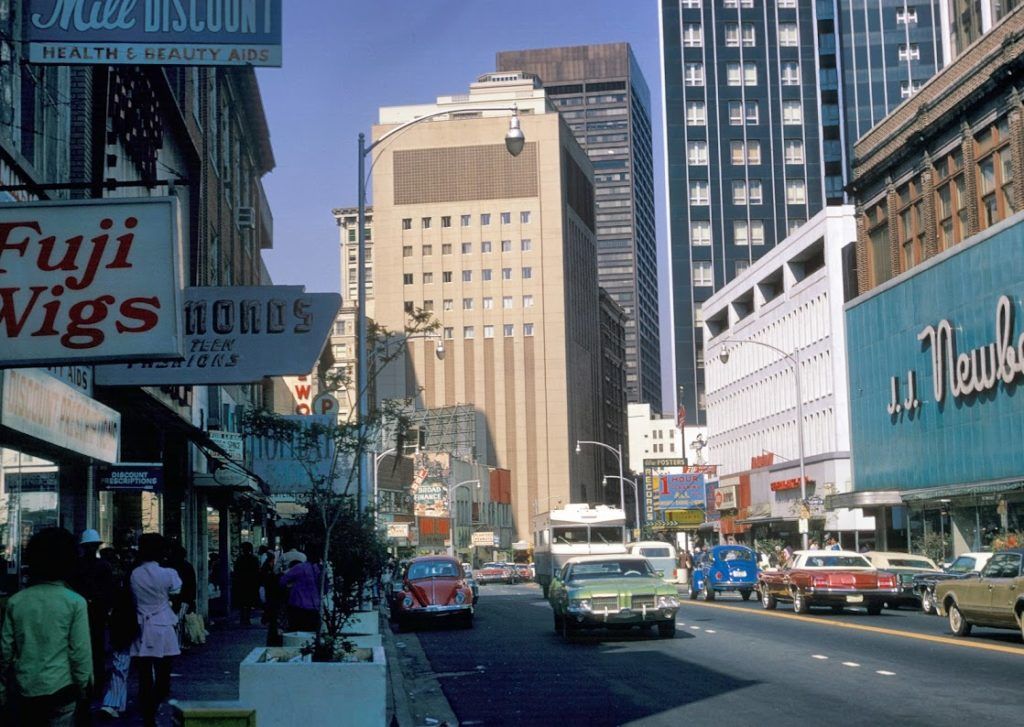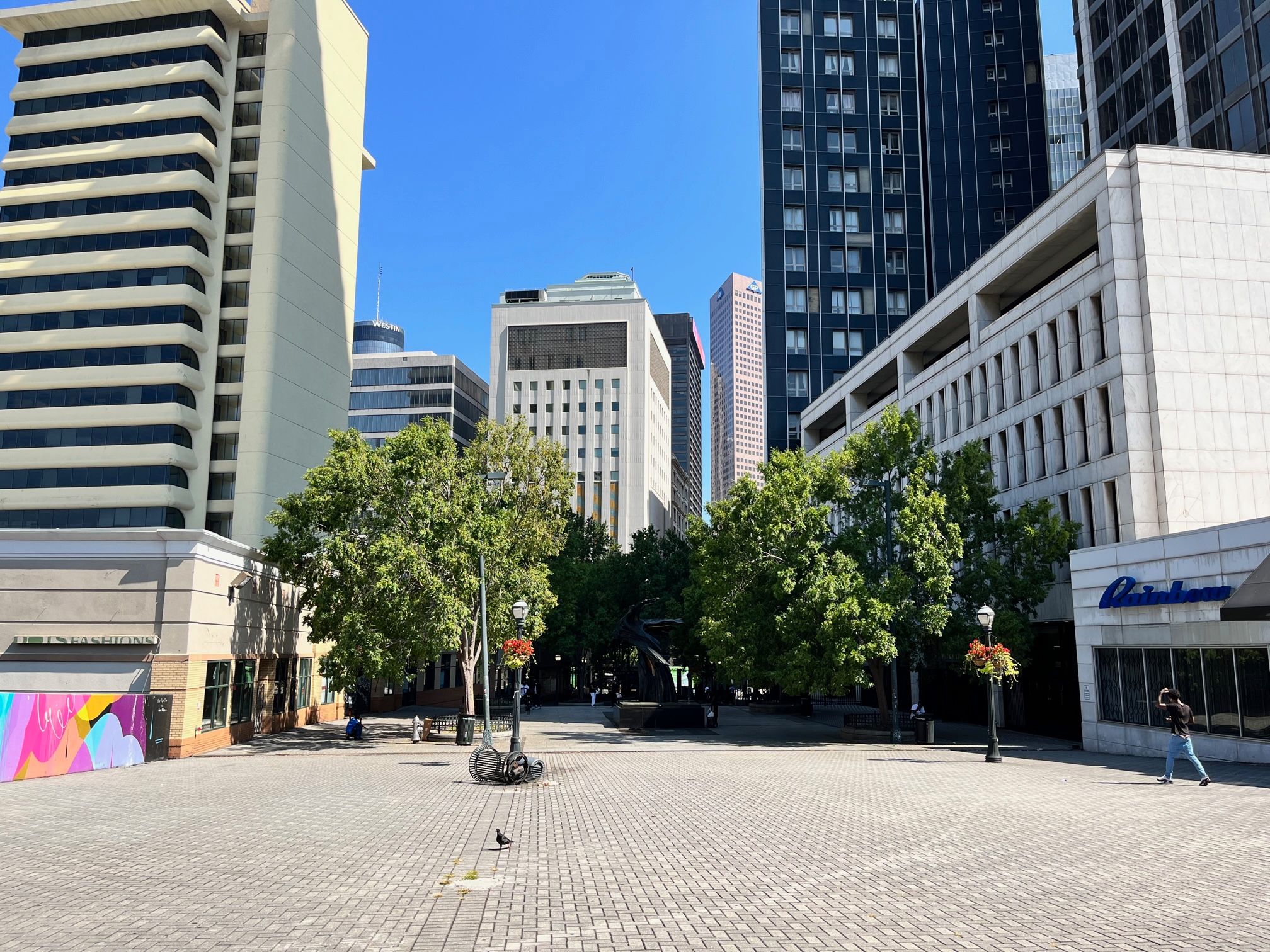Five Points Station: A Transformative Project for Downtown Atlanta
September 27, 2022
 Broad Street as a thriving downtown street in 1974 just prior to the construction of the Five Points MARTA Station. Photo credit: University of Wisconsin-Milwaukee, Harold Mayer Collection
Broad Street as a thriving downtown street in 1974 just prior to the construction of the Five Points MARTA Station. Photo credit: University of Wisconsin-Milwaukee, Harold Mayer Collection
Recently, MARTA announced the awarding of a $25 million RAISE grant for the Five Points station and publicly shared a first peek at concepts for its busiest transit station located in the heart of Downtown Atlanta. The additional funding, bringing the total project budget to $200 million, gives us an opportunity to do something truly transformative where it’s needed the most.
While early design concepts are focused on rebuilding the plaza and canopy and cementing the presence of a major hub for bus parking, the redesign of Five Points is about so much more than a transit station or transportation hub. It is about transforming our Downtown as a place. Our aspirations for Five Points should embrace the following goals:
- Improve Customer Experience: Changes to the Five Points station should dramatically improve the overall experience of MARTA customers and attract new riders. Customer experience extends beyond transit vehicles, transfer times, and the station within the fare gates: it encompasses the entire journey. In this case, customer experience and city experience are synonymous, and this project is an opportunity to redefine the relationship between Five Points and the wider Downtown experience.
- Reconnect Downtown: Five Points sits at the nexus of Downtown and South Downtown. When the station was built in the 1980s it effectively severed these two areas by closing a segment of Broad Street. South Downtown went into decline, and the Downtown market has struggled to compete with similar areas elsewhere in Atlanta and in her peer cities. Reconnecting Broad Street will support the economic success of planned developments in the area and produce new, sustained ridership for the transit system by increasing station visibility and improving the overall customer experience. A reconnected Broad Street will also improve a vital link between existing transit at Five Points and the new Summerhill BRT route, another major transit investment, two blocks south.
- Create an Exceptional Public Realm: Downtown already has a lot of plazas; many in need of their own transformations. Five Points can set a new standard and show how great streets are the key to creating an exceptional public realm. The reconnection of Broad Street and redesign of surrounding streets is vital to restoring the functionality and experience of Downtown’s street grid. These streets can be rebuilt as great urban streets that accommodate pedestrians, bicyclists, cars, and buses and support more activity and interaction. The architecture of new buildings should put front doors and active frontages along primary streets. Better streets bring more transit riders.
 Broad Street Plaza as it exists today north of the Five Points MARTA Station. Reconnecting this street would better organize the entire block for future vertical development and should be designed as an exceptional public space for all users. Photo credit: Kevin Bacon
Broad Street Plaza as it exists today north of the Five Points MARTA Station. Reconnecting this street would better organize the entire block for future vertical development and should be designed as an exceptional public space for all users. Photo credit: Kevin Bacon
- Maximize Development Potential: the two acres on which the Five Points Station currently sits has tremendous development potential: approximately 3 million square feet at 60-70 stories. Downtown has plenty of plazas and parking lots already. What it needs is the activity and vibrancy that comes from people and density. That may require patience and interim site strategies until the market is ready to take full advantage of the site’s development potential, but the site plan should, from the outset, anticipate high-density vertical development in the future as the most desirable outcome.
- Improve Bus Operations: Five Points is the most important transportation hub in Atlanta, and the efficient connection between buses and trains is critical to serving riders. However, this cannot come at the expense of everything else. Downtown is already challenged by the impact of parking and staging buses, and the transformation of Five Points is an opportunity for MARTA to reexamine bus parking and staging on valuable, urban sites. Bus stops are still essential in and around the Five Points station, but they can be designed and operated as an integral part of the street environment, not the sole proprietors of it.
The most successful and memorable cities across the globe are putting people first in the physical design of streets and public spaces. They understand it’s the key ingredient of a vibrant, thriving city. Closer to home, cities such as Washington DC and San Francisco, both with transit systems that are contemporaries of MARTA, are weaving transit stations seamlessly into the urban fabric of the cities they serve.
Most recently, the Lower Manhattan Development Corporation reconfigured the former superblock of the World Trade Center site by reconnecting key streets to accommodate private redevelopment, memorialization of 9/11, and improved transit infrastructure. The redesign has improved not only the walkability and access of the site itself; it has drastically transformed the experience of Lower Manhattan for the better.
 The re-organization of the World Trade Center site following 9/11 illustrates how improving the fundamental relationship of site and city can maximize transit accessibility when approached as an integrated endeavor. Photo credit: City of Atlanta Department of City Planning
The re-organization of the World Trade Center site following 9/11 illustrates how improving the fundamental relationship of site and city can maximize transit accessibility when approached as an integrated endeavor. Photo credit: City of Atlanta Department of City Planning
Downtown Atlanta is going to change dramatically in the next 5-10 years as long envisioned development projects such as Centennial Yards, South Downtown, and Underground Atlanta finally move forward. Five Points is the centerpiece to making sure all of these are successful and intertwined in a way that creates a cohesive and successful Downtown.
This is the moment for us to prioritize the physical design of our city to achieve the best possible urban experience. Our transportation investments have always been our single, greatest means to take on the act of city-building. These investments should always be designed from that starting point: at Five Points and anywhere transportation dollars are being spent.
About the Author
Kevin Bacon recently joined the planning and design firm of Toole Design as Director of Urban Design for the Southeast Region. Mostly recently he was employed by the City of Atlanta’s Department of City Planning. During his six-year tenure with the City he served as the Director for the Atlanta City Studio, Director for the Office of Design, and Deputy Commissioner for Strategy. He has over 14 years combined private and public sector experience as an urban designer. Kevin is a graduate of Georgia Tech’s Architecture and City and Regional Planning programs and has lived in Atlanta for over 20 years.